My
List |
Addition Date
|
Target
|
Mission
|
Instrument
|
Size
|

|
1997-12-04 |
Jupiter
|
Galileo
|
Solid-State Imaging
|
571x1000x3 |

|
-
PIA01093:
-
Turbulent Region Near Jupiter's Great Red Spot
Full Resolution:
TIFF
(2.077 MB)
JPEG
(76.4 kB)
|

|
1997-12-01 |
Ganymede
|
Galileo
|
Solid-State Imaging
|
720x379x1 |

|
-
PIA01091:
-
Complex Tectonism on Ganymede
Full Resolution:
TIFF
(265.7 kB)
JPEG
(60.23 kB)
|

|
1997-11-26 |
Ganymede
|
Galileo
|
Solid-State Imaging
|
620x540x1 |

|
-
PIA01090:
-
Khensu Crater on Ganymede
Full Resolution:
TIFF
(373.2 kB)
JPEG
(66.2 kB)
|

|
1997-11-25 |
Ganymede
|
Galileo
|
Solid-State Imaging
|
400x278x1 |
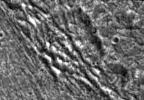
|
-
PIA01089:
-
Fractured Craters on Ganymede
Full Resolution:
TIFF
(122.6 kB)
JPEG
(23 kB)
|

|
1997-11-24 |
Ganymede
|
Galileo
|
Solid-State Imaging
|
648x460x1 |

|
-
PIA01088:
-
Nergal Crater on Ganymede
Full Resolution:
TIFF
(324.1 kB)
JPEG
(62.03 kB)
|

|
1997-11-21 |
Ganymede
|
Galileo
|
Solid-State Imaging
|
648x531x1 |
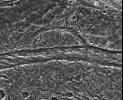
|
-
PIA01087:
-
Geological Mysteries on Ganymede
Full Resolution:
TIFF
(326.4 kB)
JPEG
(63.25 kB)
|

|
1997-11-20 |
Ganymede
|
Galileo
|
Solid-State Imaging
|
648x471x1 |

|
-
PIA01086:
-
Grooved Terrain in Nippur Sulcus on Ganymede
Full Resolution:
TIFF
(362 kB)
JPEG
(91.54 kB)
|

|
1997-11-18 |
Amalthea
|
Galileo
|
Solid-State Imaging
|
320x320x1 |

|
-
PIA01072:
-
Galileo's First Image of Amalthea
Full Resolution:
TIFF
(14.26 kB)
JPEG
(2.673 kB)
|

|
1997-11-18 |
Io
|
Galileo
|
Solid-State Imaging
|
228x113x3 |

|
-
PIA01071:
-
Changes on Io around Volund between Voyager 1 and Galileo's Second Orbit
Full Resolution:
TIFF
(75.86 kB)
JPEG
(4.377 kB)
|

|
1997-11-18 |
Io
|
Galileo
|
Solid-State Imaging
|
168x83x3 |

|
-
PIA01070:
-
Changes on Io between Voyager 1 and Galileo's Second Orbit Around an Unnamed Vent North of Prometheus
Full Resolution:
TIFF
(38.1 kB)
JPEG
(3.157 kB)
|

|
1997-11-18 |
Io
|
Galileo
|
Solid-State Imaging
|
660x600x1 |

|
-
PIA01069:
-
Active Volcanic Eruptions on Io
Full Resolution:
TIFF
(164.3 kB)
JPEG
(20.91 kB)
|

|
1997-11-18 |
Io
|
Galileo
|
Solid-State Imaging
|
153x133x3 |
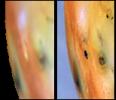
|
-
PIA01068:
-
Changes east of Pele between Galileo's First Two Orbits
Full Resolution:
TIFF
(64.12 kB)
JPEG
(4.428 kB)
|

|
1997-11-18 |
Io
|
Galileo
|
Solid-State Imaging
|
208x163x3 |

|
-
PIA01067:
-
Changes on Io around Maui and Amirani between Voyager 1 and Galileo's Second Orbit
Full Resolution:
TIFF
(107.1 kB)
JPEG
(6.949 kB)
|

|
1997-11-18 |
Io
|
Galileo
|
Solid-State Imaging
|
378x288x3 |

|
-
PIA01066:
-
Changes around Marduk Between Voyager, and Galileo's First Two Orbits
Full Resolution:
TIFF
(342.4 kB)
JPEG
(18.46 kB)
|

|
1997-11-18 |
Io
|
Galileo
|
Solid-State Imaging
|
193x143x3 |

|
-
PIA01065:
-
Lack of Visible Change Around Active Hotspots on Io
Full Resolution:
TIFF
(80.26 kB)
JPEG
(5.685 kB)
|

|
1997-11-18 |
Io
|
Galileo
|
Solid-State Imaging
|
810x1530x3 |

|
-
PIA01064:
-
Global View of Io (Natural and False/Enhanced Color)
Full Resolution:
TIFF
(4.072 MB)
JPEG
(213.7 kB)
|

|
1997-11-18 |
Io
|
Galileo
|
Solid-State Imaging
|
1600x800x3 |

|
-
PIA01063:
-
Voyager-to-Galileo Changes, Io's Anti-Jove Hemisphere
Full Resolution:
TIFF
(2.955 MB)
JPEG
(122.2 kB)
|

|
1997-11-18 |
Ganymede
|
Galileo
|
Solid-State Imaging
|
357x283x1 |

|
-
PIA01062:
-
Fractures in Transitional Terrain on Ganymede
Full Resolution:
TIFF
(120.2 kB)
JPEG
(23.79 kB)
|

|
1997-11-18 |
Ganymede
|
Galileo
|
Solid-State Imaging
|
382x341x1 |

|
-
PIA01061:
-
Secondary Craters on Ganymede
Full Resolution:
TIFF
(135.5 kB)
JPEG
(28.35 kB)
|

|
1997-11-18 |
Ganymede
|
Galileo
|
Solid-State Imaging
|
430x370x1 |

|
-
PIA01060:
-
Palimpsest Secondary Craters on Ganymede
Full Resolution:
TIFF
(170.6 kB)
JPEG
(35.86 kB)
|

|
1997-11-18 |
Ganymede
|
Galileo
|
Solid-State Imaging
|
245x203x1 |

|
-
PIA01059:
-
Grooves and Craters on Ganymede
Full Resolution:
TIFF
(59.27 kB)
JPEG
(14.41 kB)
|

|
1997-11-18 |
Ganymede
|
Galileo
|
Solid-State Imaging
|
411x431x1 |

|
-
PIA01058:
-
Bright and Dark Slopes on Ganymede
Full Resolution:
TIFF
(175.4 kB)
JPEG
(25.81 kB)
|

|
1997-11-18 |
Ganymede
|
Galileo
|
Solid-State Imaging
|
519x520x1 |

|
-
PIA01057:
-
A Polar Crater on Ganymede
Full Resolution:
TIFF
(221.8 kB)
JPEG
(36.33 kB)
|

|
1997-11-18 |
Ganymede
|
Galileo
|
Solid-State Imaging
|
321x260x1 |

|
-
PIA01056:
-
Ganymede Groove Lanes
Full Resolution:
TIFF
(87.4 kB)
JPEG
(16.72 kB)
|

|
1997-11-18 |
Callisto
|
Galileo
|
Solid-State Imaging
|
1200x1200x1 |

|
-
PIA01055:
-
View of Callisto from Voyager and Galileo
Full Resolution:
TIFF
(986.7 kB)
JPEG
(282.5 kB)
|

|
1997-11-18 |
Callisto
|
Galileo
|
Solid-State Imaging
|
1870x635x3 |

|
-
PIA00601:
-
The Galilean Satellites
Full Resolution:
TIFF
(2.108 MB)
JPEG
(144.1 kB)
|

|
1997-11-18 |
Jupiter
|
Galileo
|
Solid-State Imaging
|
1053x1491x3 |

|
-
PIA00600:
-
Family Portrait of Jupiter's Great Red Spot and the Galilean Satellites
Full Resolution:
TIFF
(2.21 MB)
JPEG
(112.7 kB)
|

|
1997-11-18 |
Io
|
Galileo
|
Solid-State Imaging
|
2284x727x3 |

|
-
PIA00585:
-
Color Global Mosaic of Io
Full Resolution:
TIFF
(5.461 MB)
JPEG
(179.4 kB)
|

|
1997-11-18 |
Ganymede
|
Galileo
|
Solid-State Imaging
|
1920x1080x3 |

|
-
PIA00521:
-
Stereo View of Ganymede's Galileo Region
Full Resolution:
TIFF
(2.568 MB)
JPEG
(204.6 kB)
|

|
1997-11-18 |
Europa
|
Galileo
|
Solid-State Imaging
|
2000x1000x3 |

|
-
PIA00502:
-
Natural and False Color Views of Europa
Full Resolution:
TIFF
(4.733 MB)
JPEG
(264.2 kB)
|

|
1997-11-18 |
Ganymede
|
Galileo
|
Solid-State Imaging
|
1920x1080x3 |

|
-
PIA00498:
-
Stereo View of Ganymede's Galileo Regio
Full Resolution:
TIFF
(2.399 MB)
JPEG
(178.4 kB)
|

|
1997-11-18 |
Ganymede
|
Galileo
|
Solid-State Imaging
|
560x905x1 |

|
-
PIA00497:
-
Ganymede's Nippur Sulcus
Full Resolution:
TIFF
(481.5 kB)
JPEG
(99.55 kB)
|

|
1997-11-18 |
Ganymede
|
Galileo
|
Solid-State Imaging
|
400x400x1 |

|
-
PIA00496:
-
Ice-frosted crater tops on Ganymede
Full Resolution:
TIFF
(162.4 kB)
JPEG
(31.02 kB)
|

|
1997-11-18 |
Io
|
Galileo
|
Solid-State Imaging
|
1215x729x3 |

|
-
PIA00495:
-
Changing volcanoes on Io
Full Resolution:
TIFF
(2.377 MB)
JPEG
(60.55 kB)
|

|
1997-11-18 |
Io
|
Galileo
|
Solid-State Imaging
|
798x787x3 |

|
-
PIA00494:
-
Io in front of Jupiter
Full Resolution:
TIFF
(2.13 MB)
JPEG
(88.84 kB)
|

|
1997-11-17 |
Io
|
Galileo
|
Solid-State Imaging
|
1401x1938x3 |

|
-
PIA01081:
-
Color Mosaic and Active Volcanic Plumes on Io
Full Resolution:
TIFF
(4.933 MB)
JPEG
(226.2 kB)
|

|
1997-11-17 |
Callisto
|
Galileo
|
Near Infrared Mapping Spectrometer
|
1800x1700x3 |

|
-
PIA01079:
-
Callisto's Southern Hemisphere as Viewed by NIMS & SSI
Full Resolution:
TIFF
(5.516 MB)
JPEG
(418.8 kB)
|

|
1997-11-17 |
Callisto
|
Galileo
|
Near Infrared Mapping Spectrometer
|
900x850x3 |

|
-
PIA01078:
-
Callisto's Southern Hemisphere
Full Resolution:
TIFF
(807.7 kB)
JPEG
(96.79 kB)
|

|
1997-11-17 |
Callisto
|
Galileo
|
Solid-State Imaging
|
1425x1625x1 |

|
-
PIA01077:
-
Large impact on Callisto's Southern Hemisphere
Full Resolution:
TIFF
(1.081 MB)
JPEG
(336.9 kB)
|

|
1997-11-04 |
Io
|
Galileo
|
Solid-State Imaging
|
200x200x1 |

|
-
PIA01073:
-
Io Plume Monitoring (frames 1-36)

Full Resolution:
|

|
1997-11-04 |
Jupiter
|
Galileo
|
Solid-State Imaging
|
313x256x1 |
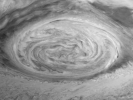
|
-
PIA01083:
-
Dynamics of Jupiter's Great Red Spot in the Near-infrared

Full Resolution:
|

|
1997-09-29 |
Jupiter
|
Galileo
|
Photopolarimeter Subsystem
|
875x605x3 |
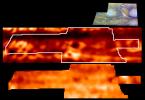
|
-
PIA00732:
-
Jupiter's Temperatures
Full Resolution:
TIFF
(771.1 kB)
JPEG
(49.91 kB)
|

|
1997-09-24 |
Jupiter
|
Galileo
|
Photopolarimeter Subsystem
|
585x376x3 |
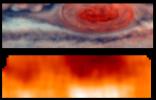
|
-
PIA00731:
-
Jovian Temperatures--Highest Resolution
Full Resolution:
TIFF
(447.1 kB)
JPEG
(17.9 kB)
|

|
1997-09-23 |
Jupiter
|
Galileo
|
Solid-State Imaging
|
614x900x1 |

|
-
PIA00605:
-
Visible Jovian Aurora
Full Resolution:
TIFF
(254.8 kB)
JPEG
(106.1 kB)
|

|
1997-09-23 |
Jupiter
|
Galileo
|
Solid-State Imaging
|
712x715x3 |

|
-
PIA00603:
-
False Color Aurora
Full Resolution:
TIFF
(1.705 MB)
JPEG
(98.67 kB)
|

|
1997-09-23 |
Jupiter
|
Galileo
|
Photopolarimeter Subsystem
|
807x700x3 |

|
-
PIA00730:
-
Jupiter's Temperatures--Broad Latitude
Full Resolution:
TIFF
(1.011 MB)
JPEG
(42.99 kB)
|

|
1997-09-10 |
Earth
|
Galileo
|
Solid-State Imaging
|
452x439x3 |

|
-
PIA00729:
-
South Polar Projection of Earth
Full Resolution:
TIFF
(169.4 kB)
JPEG
(29.01 kB)
|

|
1997-09-10 |
Earth
|
Galileo
|
Solid-State Imaging
|
1020x1128x3 |

|
-
PIA00728:
-
Global Images of Earth
Full Resolution:
TIFF
(2.169 MB)
JPEG
(117.6 kB)
|

|
1997-09-10 |
Earth
|
Galileo
|
|
620x480x3 |

|
-
PIA00727:
-
Deployment of Galileo and the IUS
Full Resolution:
TIFF
(628.2 kB)
JPEG
(37.42 kB)
|

|
1997-09-10 |
Earth
|
Galileo
|
|
420x480x3 |

|
-
PIA00726:
-
Launch of Galileo on STS-34 Atlantis
Full Resolution:
TIFF
(518.9 kB)
JPEG
(24.27 kB)
|

|
1997-09-10 |
Io
|
Galileo
|
Solid-State Imaging
|
1775x1300x3 |

|
-
PIA00293:
-
Eruption on Io
Full Resolution:
TIFF
(1.322 MB)
JPEG
(59.83 kB)
|

|
1997-09-08 |
Jupiter
|
Galileo
|
Solid-State Imaging
|
700x800x3 |

|
-
PIA00506:
-
Thunderheads on Jupiter
Full Resolution:
TIFF
(1.007 MB)
JPEG
(63.96 kB)
|

|
1997-09-08 |
Io
|
Galileo
|
Solid-State Imaging
|
2600x1150x3 |

|
-
PIA00292:
-
Three Views of Io
Full Resolution:
TIFF
(3.931 MB)
JPEG
(118.1 kB)
|

|
1997-09-08 |
Io
|
Galileo
|
Solid-State Imaging
|
700x800x3 |

|
-
PIA00282:
-
Io - Full Disk Centered on Media Regio
Full Resolution:
TIFF
(275.2 kB)
JPEG
(15.88 kB)
|

|
1997-09-07 |
Jupiter
|
Galileo
|
Solid-State Imaging
|
513x701x1 |

|
-
PIA00724:
-
Mesoscale Waves in Jupiter's Atmosphere
Full Resolution:
TIFF
(109.9 kB)
JPEG
(28.37 kB)
|

|
1997-09-07 |
Jupiter
|
Galileo
|
Solid-State Imaging
|
550x750x1 |

|
-
PIA00725:
-
Time changes in Storm Clouds in Jupiter's Atmosphere
Full Resolution:
TIFF
(132.8 kB)
JPEG
(26.9 kB)
|

|
1997-09-07 |
Europa
|
Galileo
|
Solid-State Imaging
|
1024x1024x3 |

|
-
PIA00723:
-
Context of Europa images from Galileo
Full Resolution:
TIFF
(1.121 MB)
JPEG
(105.3 kB)
|

|
1997-09-07 |
Ganymede
|
Galileo
|
Solid-State Imaging
|
523x764x1 |

|
-
PIA00722:
-
Galileo Resolutions: Ganymede and the San Francisco Bay Area
Full Resolution:
TIFF
(379.3 kB)
JPEG
(72.72 kB)
|

|
1997-09-07 |
Europa
|
Galileo
|
Solid-State Imaging
|
630x325x1 |

|
-
PIA00578:
-
Europa Ice Floes
Full Resolution:
TIFF
(226.2 kB)
JPEG
(43.25 kB)
|

|
1997-09-07 |
Ganymede
|
Galileo
|
Solid-State Imaging
|
1200x800x1 |
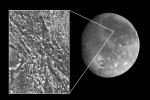
|
-
PIA00580:
-
Ganymede Galileo Regio High Resolution Mosaic Shown in Context
Full Resolution:
TIFF
(593.1 kB)
JPEG
(136 kB)
|

|
1997-09-07 |
Ganymede
|
Galileo
|
Solid-State Imaging
|
1200x800x1 |

|
-
PIA00579:
-
Ganymede Uruk Sulcus High Resolution Mosaic Shown in Context
Full Resolution:
TIFF
(628.1 kB)
JPEG
(130.6 kB)
|

|
1997-09-07 |
Jupiter
|
Galileo
|
Solid-State Imaging
|
1000x1400x1 |

|
-
PIA00720:
-
Time Series of the Great Red Spot (near-infrared filter)
Full Resolution:
TIFF
(963.9 kB)
JPEG
(121.6 kB)
|

|
1997-09-07 |
Jupiter
|
Galileo
|
Solid-State Imaging
|
2800x1600x1 |

|
-
PIA00721:
-
The Great Red Spot at Four Different Wavelengths
Full Resolution:
TIFF
(2.567 MB)
JPEG
(311.5 kB)
|

|
1997-09-07 |
Jupiter
|
Galileo
|
Solid-State Imaging
|
1400x800x1 |

|
-
PIA00719:
-
New Territory West of the Great Red Spot
Full Resolution:
TIFF
(499.6 kB)
JPEG
(62.59 kB)
|

|
1997-09-07 |
Io
|
Galileo
|
Solid-State Imaging
|
715x287x3 |

|
-
PIA00717:
-
Pele Comparisons Since 1979
Full Resolution:
TIFF
(624.4 kB)
JPEG
(21.91 kB)
|

|
1997-09-07 |
Io
|
Galileo
|
Solid-State Imaging
|
820x710x3 |

|
-
PIA00718:
-
Io's Pele Hemisphere
Full Resolution:
TIFF
(1.461 MB)
JPEG
(45.62 kB)
|

|
1997-09-07 |
Jupiter
|
Galileo
|
Solid-State Imaging
|
1546x1127x1 |

|
-
PIA00490:
-
Features of Jupiter's Great Red Spot
Full Resolution:
TIFF
(716.7 kB)
JPEG
(157.4 kB)
|

|
1997-09-07 |
Io
|
Galileo
|
Solid-State Imaging
|
2340x1475x3 |

|
-
PIA00274:
-
Io Glowing in the Dark
Full Resolution:
TIFF
(1.414 MB)
JPEG
(208.6 kB)
|

|
1997-09-07 |
Europa
|
Galileo
|
Solid-State Imaging
|
793x794x3 |

|
-
PIA00275:
-
Europa In Color
Full Resolution:
TIFF
(2.331 MB)
JPEG
(142.2 kB)
|

|
1997-09-07 |
Io
|
Galileo
|
Solid-State Imaging
|
2000x2000x3 |

|
-
PIA00491:
-
Five Color Views of Io
Full Resolution:
TIFF
(4.97 MB)
JPEG
(155.9 kB)
|

|
1997-09-07 |
Ganymede
|
Galileo
|
Solid-State Imaging
|
2470x2110x1 |

|
-
PIA00492:
-
Galileo Regio Mosaic - Galileo over Voyager Data
Full Resolution:
TIFF
(4.43 MB)
JPEG
(703.3 kB)
|

|
1997-09-07 |
Ganymede
|
Galileo
|
Solid-State Imaging
|
580x360x1 |
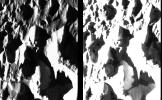
|
-
PIA00707:
-
Fine Details of the Icy Surface of Ganymede
Full Resolution:
TIFF
(108 kB)
JPEG
(47.1 kB)
|

|
1997-09-07 |
Ganymede
|
Galileo
|
Solid-State Imaging
|
800x800x1 |
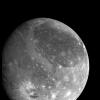
|
-
PIA00706:
-
Ganymede Global
Full Resolution:
TIFF
(371.9 kB)
JPEG
(52.96 kB)
|

|
1997-09-07 |
Jupiter
|
Galileo
|
Solid-State Imaging
|
2100x1200x3 |

|
-
PIA00489:
-
False Color Mosaic Great Red Spot
Full Resolution:
TIFF
(4.767 MB)
JPEG
(167.5 kB)
|

|
1997-09-07 |
Jupiter
|
Galileo
|
Solid-State Imaging
|
2000x1431x3 |

|
-
PIA00708:
-
True Color of Jupiter's Great Red Spot
Full Resolution:
TIFF
(3.943 MB)
JPEG
(108.4 kB)
|

|
1997-09-07 |
Jupiter
|
Galileo
|
Solid-State Imaging
|
1024x2048x3 |

|
-
PIA00296:
-
Jupiter's Great Red Spot
Full Resolution:
TIFF
(1.712 MB)
JPEG
(59.1 kB)
|

|
1997-09-07 |
Jupiter
|
Galileo
|
Solid-State Imaging
|
1400x900x1 |

|
-
PIA00488:
-
Great Red Spot Mosaic - Near-infrared Filter
Full Resolution:
TIFF
(506.6 kB)
JPEG
(76.3 kB)
|

|
1997-09-07 |
Io
|
Galileo
|
Solid-State Imaging
|
230x300x3 |

|
-
PIA00714:
-
Three Surface Changes on Io
Full Resolution:
TIFF
(144.5 kB)
JPEG
(8.796 kB)
|

|
1997-09-07 |
Io
|
Galileo
|
Solid-State Imaging
|
1620x1330x3 |

|
-
PIA00713:
-
Surface Changes on Io
Full Resolution:
TIFF
(3.614 MB)
JPEG
(133.9 kB)
|

|
1997-09-07 |
Io
|
Galileo
|
Solid-State Imaging
|
1640x1650x3 |

|
-
PIA00711:
-
Unusual Volcanic Pyroclastic Deposits on Io
Full Resolution:
TIFF
(4.224 MB)
JPEG
(179.7 kB)
|

|
1997-09-07 |
Io
|
Galileo
|
Solid-State Imaging
|
1890x1780x3 |

|
-
PIA00710:
-
Changes near the Volcano Loki Patera on Io
Full Resolution:
TIFF
(5.808 MB)
JPEG
(185.5 kB)
|

|
1997-09-07 |
Io
|
Galileo
|
Solid-State Imaging
|
2010x1640x3 |

|
-
PIA00709:
-
Massive Resurfacing of the Ionian Volcano Ra Patera
Full Resolution:
TIFF
(5.755 MB)
JPEG
(211.6 kB)
|

|
1997-09-07 |
Io
|
Galileo
|
Solid-State Imaging
|
1840x1900x3 |

|
-
PIA00712:
-
Resurfacing of the Jupiter-facing hemisphere of Io
Full Resolution:
TIFF
(4.461 MB)
JPEG
(189.4 kB)
|

|
1997-09-07 |
Io
|
Galileo
|
Solid-State Imaging
|
2400x1900x3 |

|
-
PIA00715:
-
Full Disk Views of Io (Natural and Enhanced Color)
Full Resolution:
TIFF
(7.555 MB)
JPEG
(204.3 kB)
|

|
1997-09-07 |
Europa
|
Galileo
|
Solid-State Imaging
|
968x452x1 |

|
-
PIA00291:
-
Europa's Broken Ice
Full Resolution:
TIFF
(367.8 kB)
JPEG
(81.92 kB)
|

|
1997-09-07 |
Europa
|
Galileo
|
Solid-State Imaging
|
1070x868x1 |

|
-
PIA00294:
-
Europa's Active Surface
Full Resolution:
TIFF
(732.4 kB)
JPEG
(161.1 kB)
|

|
1997-09-07 |
Ganymede
|
Galileo
|
Solid-State Imaging
|
1665x1882x1 |

|
-
PIA00493:
-
Uruk Sulcus Mosaic - Galileo over Voyager Data
Full Resolution:
TIFF
(2.82 MB)
JPEG
(463.6 kB)
|

|
1997-09-07 |
Ganymede
|
Galileo
|
Solid-State Imaging
|
574x798x1 |

|
-
PIA00279:
-
Ganymede - Ancient Impact Craters in Galileo Regio
Full Resolution:
TIFF
(526.2 kB)
JPEG
(169.6 kB)
|

|
1997-09-07 |
Ganymede
|
Galileo
|
Solid-State Imaging
|
640x480x1 |

|
-
PIA00278:
-
Ganymede - Dark Terrain in Galileo Regio
Full Resolution:
TIFF
(286.6 kB)
JPEG
(60.72 kB)
|

|
1997-09-07 |
Ganymede
|
Galileo
|
Solid-State Imaging
|
544x796x1 |

|
-
PIA00280:
-
Ganymede - Mixture of Terrains and Large Impact Crater in Uruk Sulcus Region
Full Resolution:
TIFF
(479.4 kB)
JPEG
(135.4 kB)
|

|
1997-09-07 |
Ganymede
|
Galileo
|
Solid-State Imaging
|
1097x885x1 |

|
-
PIA00705:
-
Detail of Ganymede's Uruk Sulcus Region as Viewed by Galileo and Voyager
Full Resolution:
TIFF
(1.014 MB)
JPEG
(236.1 kB)
|

|
1997-09-07 |
Ganymede
|
Galileo
|
Solid-State Imaging
|
1443x1656x1 |

|
-
PIA00281:
-
Ganymede - Galileo Mosaic Overlayed on Voyager Data in Uruk Sulcus Region
Full Resolution:
TIFF
(2.27 MB)
JPEG
(406.5 kB)
|

|
1997-09-07 |
Ganymede
|
Galileo
|
Solid-State Imaging
|
1105x798x1 |

|
-
PIA00277:
-
Ganymede - Comparison of Voyager and Galileo Resolution
Full Resolution:
TIFF
(718.2 kB)
JPEG
(148.5 kB)
|

|
1997-09-07 |
Ganymede
|
Galileo
|
Solid-State Imaging
|
526x797x1 |

|
-
PIA00276:
-
Ganymede - Ridges, Grooves, Craters and Smooth Areas of Uruk Sulcus Region
Full Resolution:
TIFF
(530 kB)
JPEG
(153.1 kB)
|

|
1996-09-12 |
Dactyl
|
Galileo
|
Solid-State Imaging
|
1000x1000x1 |

|
-
PIA00298:
-
Dactyl Dark Side Illuminated by Idashine
Full Resolution:
TIFF
(31.4 kB)
JPEG
(30.35 kB)
|

|
1996-09-12 |
Dactyl
|
Galileo
|
Solid-State Imaging
|
700x700x1 |

|
-
PIA00297:
-
High Resolution View of Dactyl
Full Resolution:
TIFF
(22.07 kB)
JPEG
(7.709 kB)
|

|
1996-09-12 |
Dactyl
|
Galileo
|
Solid-State Imaging
|
1000x1000x1 |

|
-
PIA00299:
-
Early View of Dactyl
Full Resolution:
TIFF
(88.68 kB)
JPEG
(16.34 kB)
|

|
1996-09-12 |
Ida
|
Galileo
|
Solid-State Imaging
|
2100x2130x1 |

|
-
PIA00135:
-
Asteroid Ida - Five Frame Mosaic
Full Resolution:
TIFF
(770.9 kB)
JPEG
(199.1 kB)
|

|
1996-08-13 |
Gaspra
|
Galileo
|
Solid-State Imaging
|
1350x1350x3 |

|
-
PIA00119:
-
Highest Resolution Gaspra Mosaic
Full Resolution:
TIFF
(1.005 MB)
JPEG
(68.49 kB)
|

|
1996-08-05 |
Earth
|
Galileo
|
Solid-State Imaging
|
3670x6735x3 |

|
-
PIA00133:
-
Earth - False Color Mosaic of the Andes
Full Resolution:
TIFF
(49.61 MB)
JPEG
(2.406 MB)
|

 Planetary Data System
Planetary Data System





















































































































